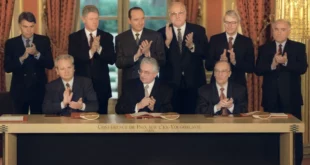On June 15, the “Promoting Education Not Indoctrination Act” was introduced in the Ohio legislature by Sarah Fowler Arthur, a first-term representative from the overwhelmingly white district of northeastern Ohio that includes both the rustbelt lake towns of Ashtabula and Conneaut and the Cleveland suburb of Chardon. Like many other bills now making their way to law in red states across America, H.B. 327 would outlaw the teaching of what its proponents label as “critical race theory” which they define as the idea that the “United States is fundamentally racist or sexist” or that anyone “is inherently racist, sexist, or oppressive, whether consciously or unconsciously.” Unlike similar measures in other G.O.P. controlled states, H.B. 327 very specifically applies its prohibitions to Ohio’s large public university system, threatening any institution that allows such teaching with a reduction of one quarter of its state funding.
In her press conference soon after successfully pushing the bill through committee, Representative Fowler Arthur was asked what was different about her bill and she responded,
“We really focus on defining the Marxist ideology…”[1] When asked to define what Marxist ideology was, Representative Fowler Arthur said that “those are specifically that one nationality, color, ethnicity, race, or sex is inherently superior to another nationality, color, ethnicity, race, or sex… So the main goal of this definition of divisive concepts is to define the ideology behind some of these Marxist ideals…”[2]Fowler Arthur may be forgiven for ginning up neo-McCarthyism with such weird and wildly inaccurate characterizations of Marxism, as she herself never went to college, and, in fact, never spent a day in a school as she was homeschooled on her Rock Creek egg farm.[3] But her bill should be taken seriously, not merely for the harm it may do to Ohio colleges and universities, but also because it is just the tip of the iceberg, or better, the feather poking from the guano pile, that is contemporary cultural conservatism.
H.B. 327, like similar bills in other states, is modelled on Trump’s Executive Order issued the last week before election day that purported to “combat” the indoctrination of government employees and contractors into the “malign ideology” of critical race theory by “woke” warriors. It variously libels critical race studies as advocating that races are essential and some races are superior to others while legislating the whitewashing of America and punishing its critics. One of its only differences in substance, besides more effectively including higher education, is that it does not make the legal unforced error of outlawing the New York Times 1619 Project, litigation bait that other states will have to defend. Rather, the bill itself is less interesting than its sponsor, a figure who symbolizes what the coattails of Trumpism has raised to power: a literally unschooled leader who has chosen as her legislative mission defining what can be taught in Ohio.
Fowler Arthur launched her political career by running for a seat on the Ohio State Board of Education in 2013. During her years as a member of the Ohio State Board of Education and chair of its Teaching, Leading and Learning Committee, Fowler Arthur’s main contribution was unsuccessfully attempting to rewrite the state’s mandated curriculum. Though her proposals were voted down, her deletions and additions are a terrifying window into the thinking of contemporary American authoritarianism.[4]
Currently, Ohio’s first grade teachers are directed that “As children work and play collaboratively, they understand the importance of fair play, good sportsmanship, respect for the rights and opinions of others, and the idea of treating others the way they want to be treated. This builds to an understanding of perspective and concern for the common good.” Arthur deleted the words “fair play” and substituted “courtesy”. The last phrase, “and concern for the common good” was struck out as well. (The phrase “common good” is also excised from second grade guidelines while third graders are not to be told that citizenship is meant to promote the “the well-being of the whole community.” Eighth graders are not to be told that the “exercise of rights must be balanced…by the common good.”)
Substituting “courtesy” for “fair play” and eliminating the promotion of the “common good” is an attempt to write competitive individualism into schoolyard ethics. “Fair play” is, after all, a notion that some means of getting ahead of others are wrong while the “common good” presupposes that the point of work and play is to benefit everyone. Rather than treating others “fairly” this mode of conservative thinking is satisfied with treating them courteously, stepping over them with good graces, saying a sweet “have a blessed day” when stealing their lunch money.
Such thinking is underscored as a few paragraphs later the reason why first graders should be taught fair play is also stripped out. Instead of mandating that “Students understand that rules need to be fair” and that fair “means justice for all parties and concern for the fair allocation of resources among diverse members of a community,” six-year-olds are to be taught to obey rules because breaking them will hurt. “Rules are established for safety, order, and justice. Justice means that each person gets what they deserve. This is why there are consequences to breaking the law or rules,” Arthur’s substitute sounds more authentic in German.
Likewise, presently, third-graders are taught that government makes and carries out laws to protect individual rights that “should focus on being safe and secure.” Fowler Arthur’s red pencil strikes that, leaving government simply to exist to ensure order and security.
In Ohio, state history is first presented to fourth graders, and here Fowler Arthur and her collaborators take what at first glance appears to be a head-scratching objection to Buckeye origins. They delete that “The Northwest Ordinance incorporated democratic ideals into the territories” and replace it with “The Northwest Ordinance incorporated democratic ideals to establish a republican style of government.” Seemingly a trivial matter of wording, this change twists the curriculum in an authoritarian direction, because to dictators democracy is not a goal or an intrinsic value but only at best a mechanism of government. Children should not be taught to love democracy, but only to respect a system of representative government.
A similar addition to the guidelines for teaching about government follows this same hobnailed logic. Unsatisfied with a tripartite definition of common governments (democracy, dictatorship, and monarchy), Fowler Arthur adds two others, “Constitutional Republic,” which she defines as “representatives are elected by the people to make public policy decisions on their behalf, rather than by a direct vote,” and “Autocracy,” which is “absolute rule by a self-appointed ruler with unlimited authority.” Where students may today be led to look kindly on “democracy” when faced with the two other choices of “dictatorship” and “monarchy,” with these additions, democracy recedes and even dictatorship’s reputation is burnished in comparison with “autocracy.” Clearly, the Fowler Arthurites wish students to consider the “Constitutional Republic” favorably as its definition is far longer and more detailed than the others.
Fowler Arthur’s discomfort with democracy becomes more pronounced as students advance through their levels. By grade six, she can’t stomach calling the USA a democracy at all. In standards for students being able to give examples of different forms of government, the USA is dropped as the sole example of a democracy and replaced with… wait for it… France! Instead, the United States is listed as an example of the newly added governmental form, the “constitutional republic” which is a “limited democratic government” in which lawmakers “make decisions on public policy for the people.”
For all their claims of color-blindness, Fowler Arthur and her anti-anti-racist warriors are quite fearful of teaching young students about different cultures or the history of racial oppression. Second grade teachers are not to be encouraged to have “cultural groups” from the “local community” come and show and tell “world cultures” as they now are. Seventh graders are not to be taught that Europeans “weakened and supplanted” the “established cultures” of indigenous peoples, rather they are to be taught that when the Europeans came “there was an amalgamation of cultures.” The Civil Rights movement was not about ending a system of racial injustice but, rather, “Dr. Martin Luther King sought a peaceful end to racial tensions.” It wasn’t just suffragists and NOW that fought for women’s rights, but so did Phyllis Schlafly’s Eagle Forum.
Weirdly, Fowler Arthur mandates that schools teach about the “Barbary Wars” when discussing Jefferson’s presidency, perhaps because TJ sent the marines to kill Muslims. I speculate here, but only because it follows a theme as the old instruction to tell students that the attacks on America on Sept. 11, 2001 led to “an increase in Islamophobia and xenophobia” is also removed.
Environmentalism is targeted as well, as second graders are not to be told that dams may “destroy animal habitats” but instead may “alter” them. Sixth graders are not to be taught that “many of the issues facing the world today” are the result of “human activities including pollution and disruption of habitat,” but only that “some” of them are. Children are not to be taught about “the shrinking of the Amazon rainforest due to deforestation.” References in current Ohio curricular guidelines to the polio vaccine or the birth control pill, are deleted, while references to the Second Amendment and gun rights are inserted throughout.
Critical thinking is under attack as the unit on teaching eighth graders how to evaluate historical sources is watered down. Rather than having students learn to evaluate historical accounts by evaluating the consistency of arguments, the perspectives and biases of authors, and cross-checking information with other “credible sources”, Fowler Arthur’s additions tell students to trust “eye witness accounts” and “source documents,” in other words, to trust anecdotal information without the rigors of evaluating their context.
Rather than have students think creatively about their government by being given an assignment to “devise and implement a plan to address a problem by engaging either the political process or the public policy process,” students should regurgitate how government works, or in Fowler Arthur’s words, “explain the process for civic engagement through either the political process or public policy process.” This same directive is repeated instead of having students think about how they would construct an argument for a “political party or interest group.”
The social vision of Fowler Arthur and her fellow culture war conservatives is rather transparent: those lucky enough to climb over their peers and be recognized as worthy citizens should follow the rules and do as their representatives tell them. Those who would promote divisive concepts such as democracy, the “common good,” thinking critically and objectively, or examining the past without national or racial bias, need to be silenced by the rules of government. But when firing teachers, be sure and be courteous. Have a blessed day.
 Eurasia Press & News
Eurasia Press & News



